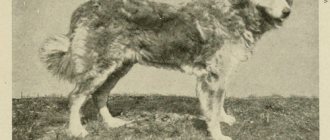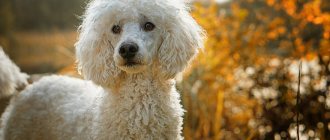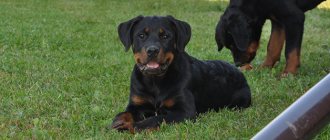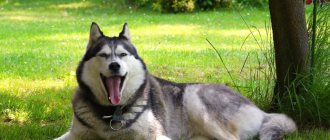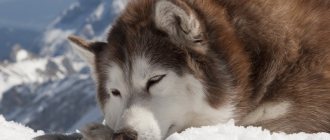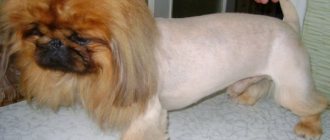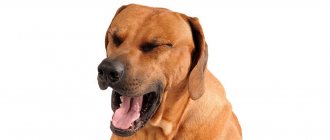History of the breed
Back at the end of the 18th century, the staff dog breed was called pit bull terrier. And in general, throughout the history of development, dogs have received quite a large number of names, among which the most famous are pit bull and half-and-half.
It was only in 1972 that the breed received its final name - Staffordshire Terrier. In America, the animal has long been considered a fighting animal. He was then seen as an impartial guard with the most optimal intelligence, size and strength.
In the 20th century Fighting traditions were practically abandoned, and the Stafford dog began to be used as a guard for large herds. Today Stafford dogs participate in exhibitions. But the main thing is that they are the best protectors for the family in which the children live. The pet will quickly take root in the house and will not show aggression towards other animals.
Origin story
The Amstaff descended from a pit bull, which was bred by crossing terriers, old-style bulldogs and some other breeds. But first things first.
Bulldogs have existed in Great Britain for a very long time, they were used for hunting, and then used for bull baiting and dog fighting. It’s just that in the 18th century they were significantly different from modern ones. These were proportionally built, agile dogs that stood on straight legs of medium length. Which terriers took part in the selection remains a controversial issue. Most likely, in each region of England these were different breeds. In Birmingham, a cross between an English White Terrier and a Bulldog gave rise to a breed that is widely popular and is known as the Bull Terrier. And the Staffordshire Bull Terrier appeared in Staffordshire. The latter were actively exported to the USA and already at the end of the 19th century became widely known overseas as the Pit Bull Terrier or the American Pit Bull Terrier.
In 1898, American pit bull breeder Shaunsey Bennett founded the United Kennel Club, which began registering first fighting and then hunting dogs. Bennett paid attention to working qualities; an important condition was the presence of a game in dogs, a desire to fight and win. But over time, more and more owners began to appear who did not want to come into contact with fighting in one way or another and saw their pets exclusively as companions. They contacted the dog breeders association and asked for registration rights. The AKC was ready to open a stud book for the American Pit Bull Terrier, but on the condition that the name of the breed would be changed. In 1936, the American Kennel Club recognized pit bulls under the name American Staffordshire Terrier. A standard was written for the breed. The goal of selection was now to breed human-friendly, sporting companion dogs that would conform in appearance to the developed standard.
Thus, the Pit Bull Terrier and Staffordshire Terrier breeds were divided, but this division can only be called conditional, since to this day their lines often intersect with each other, and some dogs have double registration in one association; they are registered as pit bulls, and in the other as Amstaffs.
Video review of the American Staffordshire Terrier (Amstaff) breed
Gallery: Staffordshire Terrier dog (25 photos)
How to choose the most suitable puppy?
When planning to choose a dog, you need to decide why a person wants to buy, for example, a black dog. After all, with proper upbringing, he will become an excellent guard, a star of exhibitions, or just a pet.
If the future owner wants to train a Mini Stafford on his own, it is better to buy a 5-month-old puppy, since at this age he is much easier to train. Older dogs that have already completed a training course are quite good. However, such animals have already acquired habits that the owner will not change.
Education and training
To raise a good Amstaff, you will have to put in a lot of effort. Difficulties may arise due to the puppy’s stubbornness and hyperactivity, as well as due to increased interest in his brothers.
Amstaff is suitable for young, energetic people who are willing to devote a lot of time to training their dog.
The Amstaff is quite trainable; it learns commands quite quickly, but may not be in a hurry to carry them out. The dog must be raised strictly, but under no circumstances should it show aggression or cruelty. Amstaff needs a patient, strong leader who will become a friend and mentor. A dog that does not recognize its owner as a leader is a problem dog.
Video: correction of unwanted behavior of Amstaff:
What you need to know about caring for an animal?
The beautiful brindle Stafford is a very neat animal. Therefore, you only need to bathe him twice a year. But you should wipe his fur with a damp towel at least once a week. This way you can get rid of fine hair and pieces of dead skin. An unusual white dog loves to be brushed. But for this procedure you do not need to use a furminator, since the dog’s fur is too short.
A gentle white puppy should be accustomed to cleanliness. You need to get him a bedding that should be washed every week. It is necessary to remember that a black or white dog does not like enclosures, since it will be much more comfortable for him to live in an apartment or house.
Representatives of such a popular breed require regular walking. The White Stafford should be outdoors every day. This dog is suitable for athletes. She will run after her owner if he wants to ride a bicycle. In places where there are large crowds of people, your pet must wear a harness.
Once you become the owner of a Staffordshire Terrier, you should take care when choosing food for your pet. For example, natural food will provide the animal with the most balanced nutrition. If the owner decides to stick to ready-made food, it is better to buy elite food in trusted stores.
Content Features
The Amstaff is not suitable for street life; moreover, the dog cannot be kept in a closed enclosure or on a leash; this affects its psyche and its behavior in the future can be unpredictable. The Amstaff is a companion dog that must constantly be in close contact with a person.
He may not sleep on the master's bed, but he must always be nearby and participate in all family affairs. During the cold season, the Amstaff requires insulation. Clothing is selected according to the season, it must be of high quality and comfortable. At home, the dog must have a sleeping place, bowls for water and food, toys and ammunition. For training, it is recommended to use a noose or a strict collar; for walking an obedient dog, a harness is the best option.
You need to walk your Amstaff a lot in order to channel all his energy into a peaceful direction.
With sufficient physical activity, the Amstaff will behave calmly at home. If a dog is not given proper attention, it will begin to spoil things and release its pent-up energy in other unwanted ways. Very active puppies are often locked in a crate while no one is home, this helps keep valuables safe. Amstaffs are very attached to their toys, but on the street they prefer to play with something larger: a brick, a tire, a log. Amstaff performs well in various sports.
Video: epic parkour of the American Staffordshire Terrier
Care
Amstaff care is simple. Periodically, the dog is brushed with a thick brush or a special mitten for short-haired breeds. This is necessary to help renew the coat and reduce the amount of wool in the house. They bathe no more than once a month. After a walk, if necessary, wipe the coat with a damp towel or rinse in the shower without shampoo. Monitor the condition of the eyes and ears, which should always remain dry and clean. The claws are slightly filed as they grow, but with good physical activity and walking on the asphalt, they grind down on their own. If the dog eats natural food, it is advisable to accustom it to brushing its teeth and perform the procedure 1-2 times a week.
Feeding
Most owners prefer to feed their Amstaff natural products. The decision is explained by the fact that good ready-made food can provide a dog with a set of vital nutrients, but does not contribute to muscle gain.
Another thing is natural nutrition, the basis of which is protein foods. On a meat diet, a dog who also plays sports looks really impressive: strong, strong with clearly visible muscle definition. A natural diet also includes a certain amount of cereals, vegetables, fruits, herbs, as well as fermented milk products, eggs and fish.
For pets who lead a moderately active lifestyle, ready-made super-premium or holistic food is also suitable. Pay attention to the diet for active medium-sized breeds.
It is enough to feed an adult dog 2 times a day. During intense physical activity, light snacks are allowed, increasing the daily diet by 20-40%. Portions should be eaten at one time.
What is known about Stafford's health?
Staffordshire Terrier puppies are required to be vaccinated against quite dangerous diseases. Representatives of such a popular breed do not have allergies, but a number of ailments can be identified, such as:
- arthrosis;
- digestive system disorder;
- ligament rupture;
- colitis;
- cataract;
- skin diseases;
- hip dysplasia.
You need to visit the veterinarian regularly with your dog. At home, it is recommended to provide your pet with adequate care in order to avoid the occurrence of any health problems.
It must be remembered that at the beginning of life, the animal’s immunity gradually develops when a sufficient amount of mother’s milk is absorbed. If your dog stops drinking it, he needs to be vaccinated, which is most often done at 6 months. In about a month you need to carry out 2 vaccinations.
Before vaccination, the animal must be given an anthelmintic drug, which must be selected by an experienced veterinarian. Then the dog should be vaccinated once a year. It must be remembered that the Stafford is vaccinated against canine distemper and hepatitis. The rabies vaccine must be given at 3 months of age.
